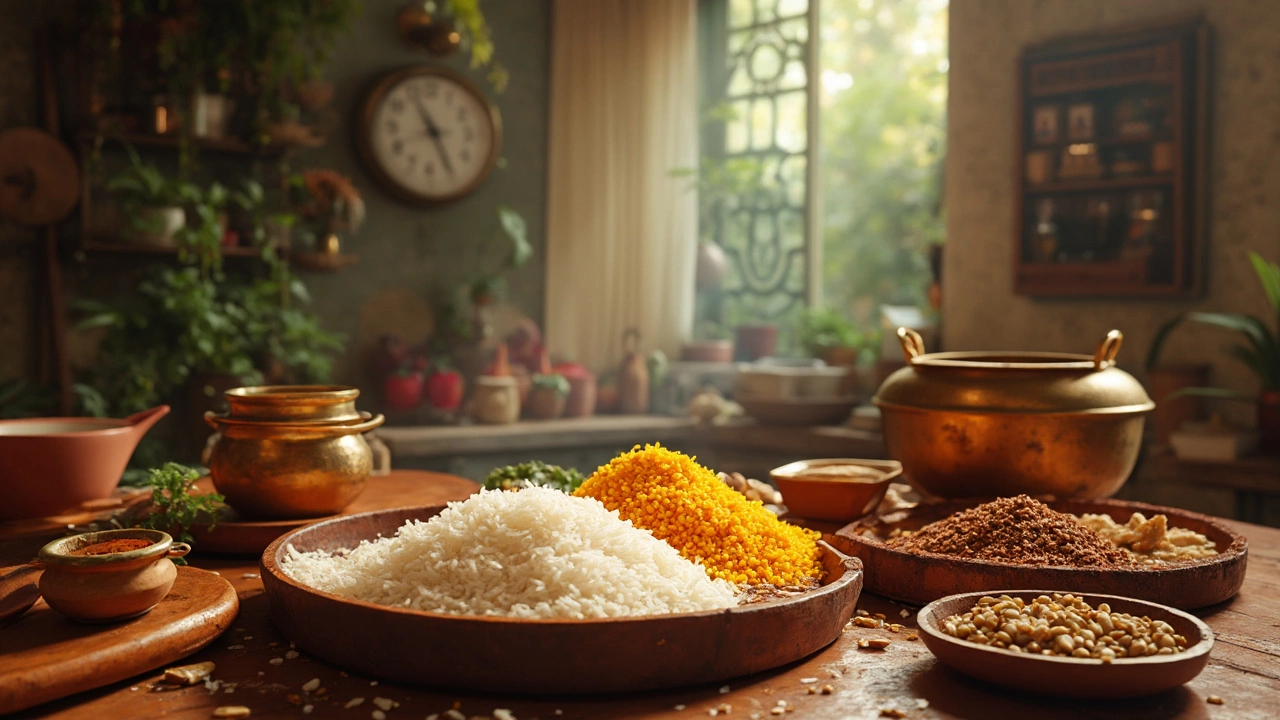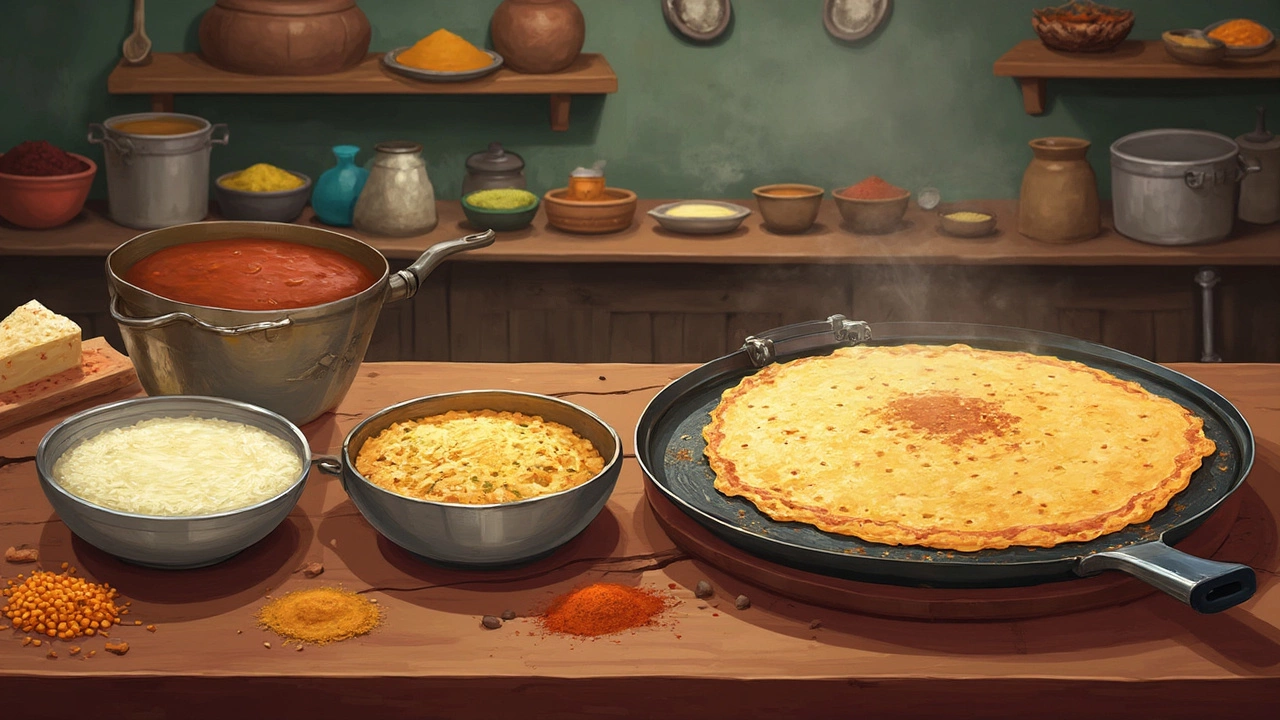How Much Time to Soak Rice and Urad Dal for Dosa?
 Apr, 10 2025
Apr, 10 2025
So, you're thinking about making dosa, huh? Well, the secret sauce—or should I say 'batter'—starts way before you even ladle it onto your pan. Yep, it's all about soaking your rice and urad dal right. We're talking about the magic that happens when you soak those grains, transforming them into your soon-to-be favorite crispy delight.
First things first: the soaking times. Rice typically needs about 4 to 6 hours while urad dal is good to go in about 4 hours. This gives them time to absorb water, soften up, and get ready for a good grinding. You might wonder, why not soak them together? Well, each grain is like its own little personality; they both need their own space, or else it’s like trying to make a smoothie with chunks—nobody wants that!
- Understanding Rice and Urad Dal
- Ideal Soaking Times
- Factors Affecting Soaking
- Tips for Better Dosa Batter
- Frequently Asked Questions
Understanding Rice and Urad Dal
Alright, let's break down the basics of what you're dealing with when preparing dosa batter. Rice and urad dal are the dynamic duo responsible for that heavenly dosa texture. Each plays a unique role, and knowing them better can really help in mastering your dosa game.
Starting with the rice. Generally, folks use raw, parboiled rice or a mix of both. Parboiled rice is partially boiled in the husk, which makes it less sticky and easier to grind—perfect for our crispy dosa quest. The choice of rice can affect the end result, so it's worth experimenting to see which tickles your taste buds.
On to urad dal, the creamy partner in this pair. It's protein-packed and adds the much-needed fermentable sugars. The right kind of urad dal, usually split and dehusked, ensures your dosa isn't just crispy but has that delightful chewiness in the center. It's like the yin to the rice's yang.
Both these components absorb water differently, which is why we don't toss them together in the soaking stage. Instead, they need tailored soaking times. Rice needs a bit longer, generally 4 to 6 hours, while urad dal is happy and ready after 4 hours or so.
Wondering why the soaking even matters? It's simple; soaking softens the rice and dal, making them perfect for grinding. Plus, it kicks off the fermentation process, essential for those tasty flavors and textures. So, understanding these two is step one in making your dosa preparation truly exceptional.
Ideal Soaking Times
Alright, so diving into the nitty-gritty of making that picture-perfect dosa, let's talk about how long you should soak your ingredients. Getting your dosa batter recipe right isn't just about mixing stuff up; it's about giving each component the right amount of time to chill in water.
For most folks aiming for spectacular dosas at home, here’s the scoop: you should let your rice bask in water for about 4 to 6 hours. That might sound like a low-key spa day for your grains, but it’s crucial. The water softens them up just enough so they grind smoothly, helping you achieve that ideal batter consistency.
As for urad dal, these little guys don't need as much soaking. About 4 hours should do the trick. The dal absorbs water pretty quickly, making it easier to create a fluffy and smooth paste that becomes the backbone of your batter. Mixing soaked rice and dal separately also ensures the unique textures are highlighted.
Quick heads up: Soaking times can slightly vary based on room temperature and quality of the grains. Warmer weather might speed things up, but sticking within this range should give you consistent results most of the time.
| Ingredient | Soaking Time |
|---|---|
| Rice | 4-6 hours |
| Urad Dal | 4 hours |
If you're in a pinch and need quicker soaking, you could try using warm water, but don't let them sit too long in warmth or it might affect the taste. Staying within these times keeps your dosa preparation straightforward and stress-free.

Factors Affecting Soaking
Okay, so you've got the basic soaking times down for your dosa batter recipe, but there's more to it than just plugging in a timer and walking away. Several factors can tweak how long you should actually soak your rice and urad dal, which means better or not-so-great crispy dosas.
First up, the temperature of your kitchen. If you live in a warm place, the grains tend to soak faster. On cooler days or seasons, you might find that they need the longer end of the soaking spectrum. It’s like Mother Nature picking up one side of the slack.
Next, think about the type of rice you're using. Some rice varieties, like parboiled rice, might take a little longer than regular raw rice. Same goes for urad dal; different grades or qualities can make the soaking time vary. So if you're testing out a new bag of rice or dal, keep an eye on how quickly they soften up.
Water quality and hardness can also come into play. Hard water may require more time for soaking, as the minerals can interfere with the soaking process. It's like your grains get a bit stubborn sometimes and need extra coaxing.
Finally, how old are your grains? Older grains might need extra soaking time because they tend to lose moisture over time. If you're not sure, just check them halfway through the soaking process.
Here's a quick breakdown:
- Temperature: Warmer days = faster soaking.
- Rice and urad dal type: Different types, different times.
- Water quality: Hard water might mean longer soaking.
- Age of grains: Older grains = potentially longer soak.
By keeping an eye on these factors, you can tweak your soaking process and soak rice for dosa like a pro. Happy dosa making!
Tips for Better Dosa Batter
Making dosa is like creating art in the kitchen. It’s all about blending the right ingredients with a good dose of patience and a bit of science. If you’ve ever dreamed of making dosas that are crispy on the outside and soft inside, here’s how you can nail it.
First off, let's talk about grinding. After you've soaked your rice and urad dal (remember those 4-6 hours!), it's grind time. Use a wet grinder if you can; it gives the batter a smoother texture. If you’re stuck with a regular blender, don’t sweat it—just add water slowly to ensure a good grind.
- Always grind dal and rice separately. Mix them later to get the best consistency.
- Keep your batter on the thicker side initially. You can always thin it down with water later, but a too-thin batter is a no-go for that crispy finish.
Fermentation is your friend here. After grinding, let the batter sit overnight (8-12 hours) in a warm spot. This is where warm climates have the upper hand, but for those shivering in the cold, keep your batter in the oven with just the light on, or use a warm towel.
Here's something interesting: adding a pinch of fenugreek seeds while soaking the dal can boost fermentation, giving your dosa that extra golden brown color. And remember, adding salt before fermenting helps the process, plus it’s a must for taste. But hey, don’t go overboard.
Now, let’s address the elephant in the room—your dosas are sticking to the pan. The trick? A well-seasoned cast-iron pan or non-stick skillet. Use a ladle to spread the batter quickly in circular motions, starting from the center outwards. Cooking on medium-high heat helps too.

Frequently Asked Questions
Q: Can I soak rice and urad dal together for making dosa batter?
A: It's better to soak them separately. Rice and urad dal have different absorption rates and characteristics. Mixing them up without proper soaking may lead to an uneven batter, affecting the dosa preparation. Try soaking rice for 4-6 hours and urad dal for about 4 hours for the best results.
Q: What happens if I soak them for too long?
A: Over-soaking can lead to fermentation, especially in warmer climates, which can change the taste and texture. Keep an eye on the soaking times, and remember that a slight sourness might develop if you can't manage to grind them right after they're soaked.
Q: Do the quality of rice and urad dal matter?
A: Yes, definitely! Using the right quality ingredients affects everything, from soaking to grinding to fermenting. And ultimately, they affect that delightful crispiness of your dosa. Choose high-quality grains for a consistently good outcome.
Q: Any quick tips for better fermentation after soaking?
A: Ensure your soaked grains are ground into a fine batter and leave enough room for it to rise during fermentation. Adding a pinch of fenugreek can help boost fermentation. This often gives that lovely tangy taste!
"Remember, good things come to those who wait...and soak," says Chef Ram, an award-winning culinary expert on traditional South Indian cuisines. "Dosa mastery is all about the perfect timing at every step."